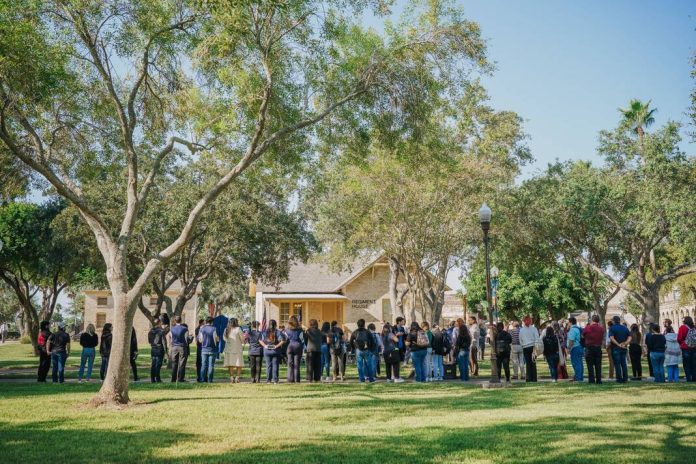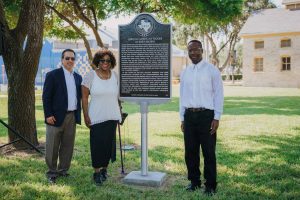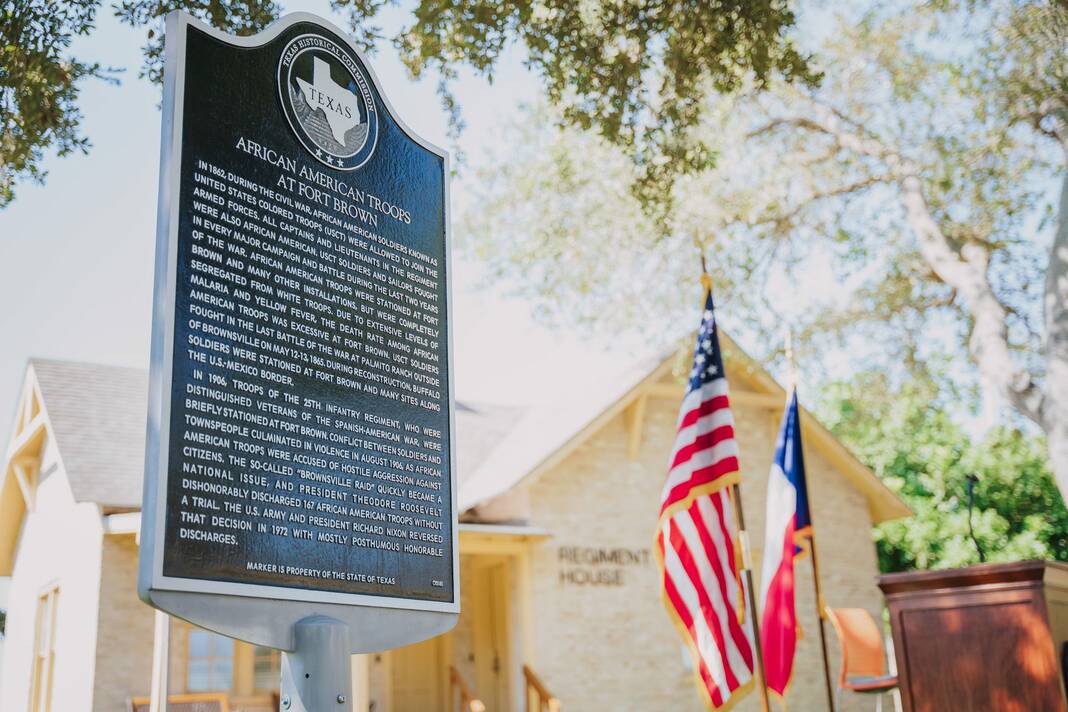
|
Only have a minute? Listen instead
Getting your Trinity Audio player ready...
|

Amid a look reminiscent of the era, Texas Southmost College on Thursday dedicated a plaque honoring African American U.S. Army troops who served at Fort Brown during the Civil War and early 1900s.
The ceremony took place in front of Regiment House on the TSC campus, a Civil War-era building, although the segregated troops, officially known as United States Colored Troops and later referred to as Buffalo Soldiers, never lived there. They were only allowed to live in tents in a swampy area near the river at the far end of what is now the TSC campus, and was then Fort Brown.
“So, there you have it. This is to honor the African American troops, USCT, who served at Fort Brown,” retired longtime professor Tony Zavaleta, a member of the TSC Board of Trustees, said as the ceremony concluded.
Zavaleta read the plaque after it was unveiled. Participants in the ceremony all wore white guyaberas, shirts or blouses and dark skirts or trousers.
Zavaleta, a Ph.D and anthropologist, is regarded as one of the top experts on the U.S.-Mexico border. He frequently speaks throughout Mexico and the U.S., according to the TSC website.
Zavaleta said Black soldiers were never treated equally during the Civil War and afterward during Reconstruction. President Abraham Lincoln officially allowed them to enter the U.S. Army in 1862, and they fought in every major battle during the last two years of the war.
“The Buffalo Soldiers was a term that came later after their encounters with Native Americans in the west. … African American soldiers at Fort Brown suffered, I emphasize suffered with a capital S, tremendous problems. They were given used and old second-hand rifles. The new rifles that were appearing, rapid multi-fire rifles, were not issued to African American soldiers. The uniforms were old and tattered, not modern and new uniforms. They were not fed equally. They were not housed equally at the far end of the campus, way down there, was a very swampy area, and that’s where they were required to live in tents,” Zavaleta said.
“And finally, they were not allowed to be treated in the hospital. Only white troops were allowed to be treated in the hospital, and so as a result they contracted yellow fever, malaria and many other illnesses, and they died in great numbers. They died in such great numbers that their units no longer had enough people to bury them,” he said.
He added: “I want to take the privilege to call upon all the spirits of every African American soldier that lived or died or served here to come and be with us this morning. It was my dream when I became a member of the Texas Southmost College Board of Trustees to have this plaque established honoring African American troops. Today we have it and we unveil it, and many people will walk down this historic avenue, pass by it and read it,” he said.
“Most of you don’t know that we had a national cemetery here, over where the Fort Brown Hotel used to be. We had a national cemetery with more than 3,000 soldiers and others buried there. And in 1911, which was after the so-called Brownsville raid of 1906, the city of Brownsville, which was a very racist place, Brownsville was a Confederate town, ordered a construction company to dig up all of those bodies and move them in railroad cars to Alexandria, Louisiana, where they rest today.”

“And today there’s a plaque (in Louisiana) that says the bodies of unknown soldiers are buried there. I want you to know that every single one of those soldiers was known, and there was a grave marker for every single one, and there was a name and rank and origin and town where they came from. And we still have it and it’s my dream that as we continue with this, Texas Southmost College will have a website with all of that information on it, so a family doing genealogical research that wants to know what happened to their grandfather, their great grandfather, can go to that site and find out. It’s very important,” Zavaleta said.
In 2005, Zavaleta published a paper titled “Colored Death: The Tragedy of Black Troops at Fort Brown, Brownsville, 1865-1906.”
“My fifty plus years on the campus of Texas Southmost College and The University of Texas at Brownsville (Fort Brown); connections to our family ranch on Palmito Hill (Last Battle of the Civil War); and to my Great-Great Grandfather, Juan Nepomuceno Cortina, (so-called Border Bandit), have urged me to constantly question Brownsville history as I’ve learned it,” the paper states.
The paper is 73 pages long and numbers 116,668 words. Many thousands of U.S. Colored Troops served on the U.S.-Mexico border after the Civil War and played an important role in securing the border’s entire 2,000-mile length, which was then in dispute.
After the remains of the bodies buried in the cemetery at Fort Brown were shipped to Louisiana by rail car, the U.S. government ordered the destruction of Regiment House because it was in the way of expansion plans in the mid-1980s.
“The U.S. Army put them in a mass grave marked unknown soldiers from Brownsville, Texas, and that’s totally false and offensive,” Zavaleta said.
Zavaleta, who was then a member of the Brownsville City Commission, convinced the city to preserve the building. It was dismantled brick by brick, stored for many years at the Brownsville compress property, and reconstructed on the TSC campus, he said.
The plaque makes reference to the Brownsville Raid of August 1906, during which tensions between Brownsville residents and Black soldiers of the 26th Infantry Regiment stationed at Fort Brown culminated in violence.
The incident became a national issue. President Theodore Roosevelt, who was running for re-election, dishonorably discharged 167 soldiers.
In 1972, President Richard Nixon reversed the decision, granting mostly posthumous honorable discharges, the plaque states.



